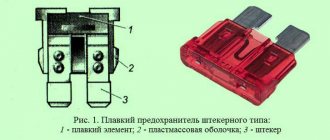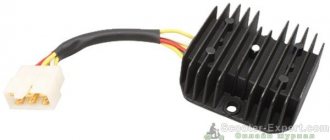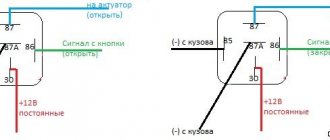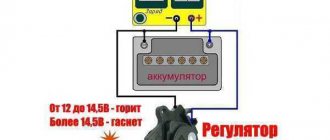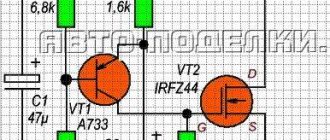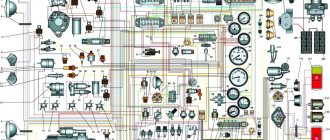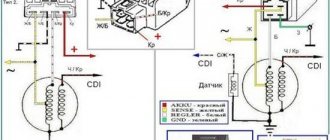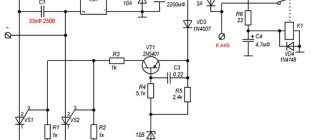This article discusses the fuse and relay diagrams of the Mazda 3 bk (Mazda 3bk) first generation, from the Japanese concern Mazda Motor Corporation, produced in 2003, 2004, 2005, 2006, 2007, 2008 and 2009 with engines of 1.4 liters, 1.6 liters . and 2.0 l.
Interesting fact: in its homeland (Japan) this model is called Mazda Axela.
During this time, the sedan and hatchback managed to undergo restyling.
The location and decoding of fuse and relay blocks may differ from that discussed below, depending on the configuration and modification, as well as the year of manufacture, of your Mazda 3 bk.
This vehicle is equipped with 2 main fuse and relay mounting blocks located in the passenger compartment and under the hood.
Fuses and relays in the cabin
The Mazda 3 bk interior mounting block of fuses and relays is located under the glove compartment on the passenger side.
Most fuses are located in this block.
In order to get to the cabin fuses and relays, you must:
- Pull out the plastic clip from the right protective cover in the passenger footwell and move it to the side;
- Remove the protective plastic fuse cover by pressing out the two plastic clips located on both sides of the protective cover;
- Next, you need to rotate both fasteners (on both sides) by 90%, which hold the mounting block;
- Now the block can be lowered down and pushed forward a little for the convenience of replacing fuses and relays, thanks to special bracket holders.
General view of the Mazda 3 bk interior fuse box
Diagram of fuses and relays in the Mazda 3 bk interior
| No. on the diagram | Fuse rating | Protected circuit |
| 37 | 15 A | Central locking (D/LOCK 2) |
| 38 | Empty or 10A (on later models; depending on configuration) | Empty (Reserve); On later models - STOP LAMP Fuse, Horn (STOP LAMP/HORN) |
| 39 | 10 A | High beam (Left headlight) (HEAD HIGH L) |
| 40 | 10 A | High beam (Right headlight) (HEAD HIGH R) |
| 41 | — | Empty (Reserved) |
| 42 | — | Empty (Reserved) |
| 43 | 15 A | Cigarette lighter Mazda 3 (Lighter/Cigar) |
| 44 | 7.5 A | Stereo, Audio system, Radio (RADIO) |
| 45 | 10 A | Electric adjustment of side rear view mirrors (Mirror) |
| 46 | 7.5 A | Dimensions (Right side front and rear marker lights), Number plate (registration plate) illumination (TAIL R) |
| 47 | 10 A | Diagnostic connector (OBD) |
| 48 | — | Empty (Reserved) |
| 49 | 20 A | Ignition switch circuit (TR/Lock) |
| 50 | 10 A | Electronic control unit for electrical equipment (CPU PWR, microcomputer start) |
| 51 | 15 A | Hazard lights (hazard warning lights) and turn signals (direction indicators) (HAZARDs) |
| 52 | 20 A | Sunroof (its electric drive) (SUN ROOF) |
| 53 | 20 A | Front windshield washers (WASHER) |
| 54 | — | Empty (Reserved) |
| 55 | 30 A | Power windows on the right side (front and rear) (P/WIND R) |
| 56 | 30 A | Window lifters on the left side (front and rear) (P/WIND L) |
| 57 | 7.5 A | Security alarm (ALARM) |
| 58 | 7.5 A | Heated exterior mirrors (electrically heated windows) (M/DEF) |
| 59 | — | Empty (Reserved) |
| 60 | 15 A | Low beam (Right headlight) (HEAD LOW R), lamp adjustment |
| 61 | 15 A | Low beam (Left headlight) (HEAD LOW L), lamp adjustment |
| 62 | — | Empty (Reserved) |
| 63 | — | Empty (Reserved) |
| 64 | — | Empty (Reserved) |
| 65 | 10 A | Airbag system (SRS Airbag) |
| 66 | 10 A | Immobilizer (anti-theft system), Instrument panel/instrumentation, ignition key interlock system (METER) |
| 67 | 20 A | Anti-lock braking system (ABS), directional stability control (DSC), power steering and electric pump (EHPAS), (IGNITION) |
| 68 | 20 A | Wipers (windshield wipers) (WIPER) |
| 69 | 20 A | Electronic engine management system (ENGINE) |
| 70 | 10 A | Egnition lock; Automatic wiper (IG SIG) (some models) |
| 71 | 7.5 A | Airbag system (SRS 2) |
| 72 | — | Empty (Reserved) |
| 73 | — | Empty (Reserved) |
| 74 | 20 A | Heated seats (heating) (SEAT WARM) |
| 75 | 25 A | Central locking (D/LOCK 1) |
| 76 | 10 A | Air conditioning, air conditioning compressor clutch, (A/C) |
| 77 | 30 A | Front right window regulator P/WIND R |
| 78 | 30 A | Front left window regulator P/WIND L |
| 79 | 10 A | Reversing lights (lamp lights when moving backwards) (BACK) |
| 80 | 7.5 A | Sunroof (electric) (SUN ROOF) |
| 81 | 7.5 A | Tail light (left), front marker light (left) (TAIL L) |
| 82 | 7.5 A | Fog lights (fog lights), instrument panel and control module lighting/illuminations (ILLUMI) |
| 83 | — | Empty (Reserved) |
| 84 | — | Empty (Reserved) |
| 85 | — | Empty (Reserved) |
| 86 | — | Empty (Reserved) |
The cigarette lighter fuse is number 43 with a current of 15 Amps. Depending on the modification of the car, there may be other problems; we also recommend checking number 28 for 10 Amperes under the hood.
Relay box in the cabin
You can get to the main relay blocks/sensors in the Mazda 3 bk interior after you completely remove and disconnect from the plugs that fit it, the interior mounting block with fuses and open (unscrew) the white plastic case protecting the main board where the relays are located.
Remove the fuse and relay mounting block
The protective casing was removed. Assembly block disassembled.
The relay circuit is shown in the figure above along with the fuses. Explanation in the table below.
| No. on the diagram | Protected circuit |
| R11 | Relay for reduced (first) speed of front wipers (windshield wiper) |
| R12 | Relay for the second speed of the front wipers (windshield wipers) |
| R13 | High beam headlight relay unit |
| R14 | Relay for turning on side lights/lanterns |
| R15 | Empty (Reserved) |
| R16 | Empty (Reserved) |
| R17 | Relay for blocking the central locking drives (closing the lock) |
| R18 | Relay for unlocking the central locking drives (opening the lock) |
| R19 | Relay for turning on the rear wiper (wiper), if equipped |
| R20 | Empty (Reserved) |
The video below clearly demonstrates the location of the relays responsible for the wipers and the removal of the mounting block where they are located.
Recommendations for servicing the mounting block
- Periodically check the condition of the fuses, replace with new ones as necessary;
- After long trips through puddles or in the rain, check for moisture and condensation in the mounting block. Dry the board with a stream of compressed air;
- Install modules with similar current strength (amperage). Do not exceed (underestimate) Amperes;
- If the mechanism suddenly stops functioning, do not rush to replace it with a new one. Check the module status, use a multimeter to diagnose;
- During preventive maintenance, check the quality of fixation of terminals and limit switches. Press with pliers as needed.
Despite the apparent simplicity of the design of the mounting block, carry out diagnostic work at a service station. Unprofessional intervention in repairs leads to undesirable consequences.
Fuses and relays under the hood
In the engine compartment, the fuse and relay box is located next to the battery.
In order to get to the “under-hood” fuses and relays, you need to remove the protective plastic cover by pulling the latch on the side of the mounting block and move it to the side.
General view of the block under the hood of Mazda 3 bk
Fuse and relay diagram in the engine compartment
| № | Denomination | Protected circuit |
| 1 | 40 A | Cooling fan (radiator) (FAN) |
| 2 | 80 A | Electric power steering pump (P/ST - EHPAS) |
| 3 | 40 A | Connector for diagnostics, Hazard warning lights, Front wipers, front windshield washers, central locking, dimensions (BTN) |
| 4 | 40 A | Headlights (HEAD) |
| 5 | 80 A | PTC circuit (EPVA, cabin air heater) (On some models) |
| 6 | (Blank) or 60 A | Empty (Reserve); in later models - 60 A glow plugs (GLOW) |
| 7 | 30 A | Brake system (ABS, abs), directional stability system (DSC) (anti-skid); [ABS1] |
| 8 | 20 A | Brake system (ABS, abs), directional stability system (DSC) (anti-skid); [ABS2] |
| 9 | 30 A | Electronic Engine Control Relay |
| 10 | — | Empty (Reserved) |
| 11 | 30 A | Ignition switch (lock) (electrical consumer circuits activated when the ignition is started and not turned off when the starter is turned on) (IG KEY1) |
| 12 | 20 A | Starter solenoid relay (clutch) |
| 13 | 30 A | Ignition switch (lock) (electrical consumer circuits activated when the ignition is started and turned off when the starter is turned on) (IG KEY2) |
| 14 | 30 A | Glow plugs (some models) (GLOW1) |
| 15 | 40 A | Heater (cabin fan) (HEATER) |
| 16 | 30 A | Glow plugs (some models) (GLOW2) |
| 17 | 40 A | Heated / Heated rear window (electric) (DEFOG) |
| 18 | 30 A | Empty (reserve); or -Audio system (for models equipped with a BOSE audio system) (AUDIO) |
| 19 | 10 A | ABS brake system (ABS), directional (anti-skid) stability system (DSC); |
| 20 | 15 A | Front fog lights (fog lights) (FOG) |
| 21 | 15 A | Sound signal (horn, horn) (HORN) |
| 22 | 10 A | Daytime running lights (DRL) on some models |
| 23 | 20 A | Headlight washers (H/CLEAN) |
| 24 | 15 A | Fuel pump (fuel pump) (F/PUMP) |
| 25 | 10 A | (Power steering) Power steering (on some models) (P/ST IG) |
| 26 | 10 A | Air Conditioning Compressor Electromagnetic Clutch (A/C MAG) |
| 27 | 10 A | Generator (ALT/TCM 1GA) |
| 28 | 10 A | Cigarette lighter (GLOWSIG) |
| 29 | 10 A | Power supply for additional car sockets (P.OUTLET) |
| 30 | 10 A | Engine control unit PCM, control unit for dosing and supply of fuel additive (ENG+B) |
| 31 | 15 A | Instrument cluster: Interior lighting lamps (interior lights, lampshades) (ROOM); RADIO (Audio system) |
| 32 | 10 A | Oxygen concentration sensor (ENG BAR 4) |
| 33 | 10 A | Oxygen concentration sensor (ENG BAR 3) |
| 34 | 10 A | Injector pre-body, injector (EGI INJ) |
| 35 | 10 A | Mass Air Flow Sensor (MAF) Fuse (ENG BAR 1) |
| 36 | 10 A | (USR) Exhaust gas recirculation system, valve (ENG BAR 2) |
Relay under the hood
| No. on the diagram | Protected circuit |
| R1 | Fog lamp relay (fog lights) FOG |
| R2 | Horn Relay (HORN) |
| R3 | Heated/defogged rear windshield (DEFOG) relay |
| R4 | ETV circuit relay |
| R5 | Fuel heating relay for diesel models (F/WARM) |
| R6 | Fuel pump relay (CIRCUIT) |
| R7 | Empty (Reserved) |
| R8 | Empty (Reserved) |
| R9 | Headlight washer relay (H/CLEAN) |
| R10 | Climate control fan relay (heater) (HEATER) |
| R11 | Air Conditioning Relay (clutch, compressor) (A/C) |
| R12 | Empty (Reserved) |
| R13 | Starter relay (retractor) (STARTER) |
| R14 | Electronic engine control unit (MAIN) |
Reasons for fuses failure on Mazda 3
- Violation of the schedule developed by the manufacturer for routine technical inspection of the vehicle;
- Purchase of non-original components, low-quality wiring;
- Violation of installation technology;
- Damage to adjacent mechanisms, which resulted in failure of the power supply unit;
- Short circuit in the electrical supply circuit;
- Damage to the insulation layer;
- Oxidation of contacts;
- Loose terminal fixation;
- Moisture getting inside, condensation forming.
How to find its installation location in the car
In order to find the installation location of a specific fuse, you must use the vehicle's owner's manual. Not all manuals have information about fuse boxes. The most common places for their installation:
- in the engine compartment on the driver's side;
- near the positive terminal of the battery;
- in the cabin under the dashboard;
- in the cabin in the glove compartment area;
- at the ends of the torpedo;
- under the rear seat (in some BMW models);
- in the trunk under the upholstery on the right or left side.
There are special resources on the Internet where you can find the location of these blocks and specifically the fuses that serve certain systems and devices of cars.
Self-replacement of Mazda 3 filters. Work order:
1. First remove the Mazda 3 fuel level sensor.
2. Carefully unclip the lower part of the Mazda 3 filter housing (4 latches).
3. Remove the lower housing.
4. Remove the Mazda 3 coarse fuel filter.
5. Replace it with a new one.
6. To remove the Mazda 3 fine filter, pull out and disconnect the fuel pump.
7. To disconnect the upper part of the housing from the filter, use a screwdriver to press out the 2 latches inside.
8. Pull out the filter.
9. Cut the fuel hose at the top and remove the filter itself.
10. Replace the fine filter of the Mazda 3 and put on the tube, having previously warmed it over the fire so that it becomes soft. Then quickly put it on the pump. For reliability, secure the tube with a clamp.
11. Put on a new Mazda 3 coarse filter and reassemble the structure in the reverse order. Install the filter into the fuel tank.
12. Reinstall the fuel tank and reassemble everything in reverse order.
Calculation of its nominal value when installing additional equipment
When installing additional equipment, it is often necessary to change the fuse rating in the power circuit. To calculate, you must have data on the power of the device or its resistance. For example, when connecting an additional lighting source in the form of a 60-watt lamp, you must use the formula:
P=U*I, where
- P – lamp power,
- U – on-board network voltage (12 Volts),
- I – current in the circuit.
From the formula it follows:
I = P/U = 60/12 = 5 Amps.
That is, when installing an additional lamp, it is necessary to increase the fuse rating in the circuit by approximately 5 Amperes, taking into account the current reserve of 50%, you must select 7.5 Amperes. If two lamps are installed in the circuit, then the rating is multiplied by 2, resulting in 15 Amperes.
If the power of the device is unknown, its resistance is measured. The measurement should be made with a good multimeter, since Chinese ones have a large error, especially when measuring small resistances. For example, when installing the notorious electric air heater in the cabin, measurements showed a resistance R of 0.4 Ohm. The current is determined by Ohm's law.
I = U/R = 12/0.4 = 30 Amps
If you connect only a heater to the cigarette lighter socket, taking into account the margin, the fuse rating must be at least 40 Amps.
Video - choosing high-quality automotive fuses, checking them for integrity, calculating the rating:
It should be taken into account that usually when calculating the cross-sectional area of a conductor, the maximum current per 1 sq. mm of conductor cross-section is taken to be a maximum current of 4 Amperes. Thus, the cross-sectional area of the wire going to the cigarette lighter connector must be greater than 30/4 = 7.5 sq. mm. The nearest standard section is 8 sq. mm. (surely there is a wire there with a cross-section of no more than 6 sq. mm.) If you want to light a cigarette while the heater is operating (using a double connector), the current may increase, and this can lead to a blown fuse, or even worse, ignition of the wiring.
If the accessory is powered from a fuse block, it is also necessary to increase the rating of the high-power fuse that serves this block. It is usually located under the hood or in the trunk if the battery is located there.
